
Original Link: https://www.anandtech.com/show/2158
Value Cooling: Two Towers for under $30
by Wesley Fink on January 23, 2007 3:50 AM EST- Posted in
- Cases/Cooling/PSUs
Once you progress beyond the basic heatsink with a fan on top, the big thing in air cooling is the tower cooler. A combination of heatpipes, aluminum cooling fins, and large, quiet low-rpm fans, the tower coolers are very effective. This was clearly demonstrated in the recent AnandTech review of the Tuniq Tower.
However, the added efficiency is not without a few compromises. Most of the effective tower coolers are extremely large, with many barely fitting in a standard case. Prices are also at the upper end of the air cooling spectrum, although $50 to $80 for an effective tower cooler must still be considered a bargain compared to other computer components. The big towers are also normally heavy, exceeding manufacturers' maximum recommendations for heatsink weight.
This added weight has not been a particular problem in desktop/tower setups with a secure motherboard, but it can be a real issue for those who take their PCs with them to LAN parties, for example. Anyone who has ordered a PC and had it shipped to them has sometimes been greeted by a CPU heatsink/fan that worked its way off during transport. Moving a PC with a heavy and bulky cooling tower is risky.
Despite these concerns there is one thing that is difficult to ignore with the big tower coolers. They cool exceptionally well, lowering CPU temperature dramatically and extending overclocking capabilities of the systems that use them. That is certainly why the design is so attractive in today's market.
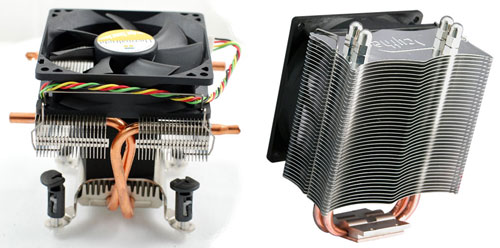
Several manufacturers have tried to produce lighter and cheaper cooling towers in an effort to address some of these concerns. Two such efforts are the focus of today's review - a comparison of the new Thermalright MST-9775 and the Scythe Katana. Both Thermalright and Scythe are big names in the cooling tower business, with Scythe producing the Scythe Infinity and Thermalright marketing the Thermalright Ultra 120.
The Scythe Katana and Thermalright MST-9775 are a different approach to the cooling problem. While both are tower inspired, they are both very lightweight. To put this in perspective keep in mind that the excellent Tuniq Tower weighs about a kilogram (2.2 lbs) with a 120mm fan. The Scythe Katana weighs around 300g and the Thermalright MST-9775 tips the scale at just 425g with the supplied fan. These specifications are well within the Intel and AMD specifications for any motherboard either cooler can be used with.
Both coolers are also much smaller than most towers, meaning they will fit almost any motherboard and case. The cost is also low. The Katana and MST-9775 normally sell for less than $30, and we found them both selling around $25 at several sites. The Thermalright MST-9775 was just recently introduced and it was supplied to AT by Frozen CPU, which always seems to have the latest in cooling. The Scythe Katana was purchased for review.
All of this is good, but it really doesn't mean much unless the coolers deliver better performance than the stock cooler. There are a couple of questions then. First, can the coolers outperform our retail Intel cooler? If they can, is there any reason to spend more on the big towers like the Tuniq or Infinity?
Thermalright MST-9775
Most hobbyists first heard of Thermalright when their SK-6 cooler appeared in the summer of 2001 and started winning most of the heatsink roundups. Since then Thermalright has become a well-respected name in high-end air cooling. Thermalright emphasizes their design capabilities in the cooling market, and their advanced manufacturing processes that are ISO-9000 certified.
Thermalright also produced several well-known heatsinks for the AMD K8 and Pentium 4 sockets, such as the legendary XP-120 and XP-90 heatsinks. You bought the Thermalright heatsink and paired it with the 120mm or 90mm fan of your choice - for low noise or massive air flow or some combination that met your needs.
The MST-9775 is a new Thermalright product and a bit of a departure from what you might expect. First of all the unit is a complete cooling solution - including the fan. Second the price tag is a very reasonable $25. While Thermalright has a reputation for delivering great value, their prices have rarely been in the price range of the MST-9775.
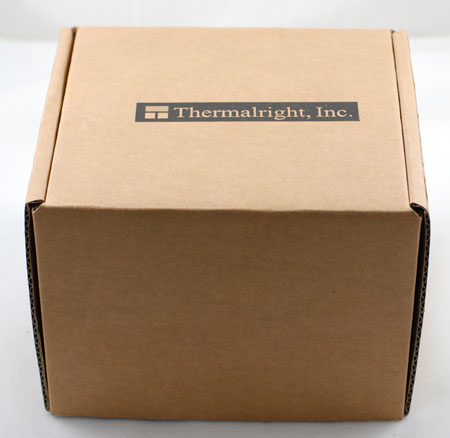
Thermalright has never cared much about glitzy packaging. All the Thermalright coolers we have seen are shipped in sturdy natural cardboard boxes.
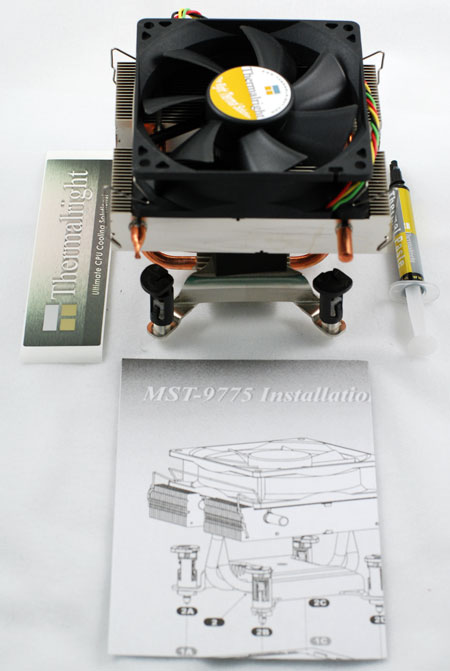
Inside the plain brown box you will find everything you need to mount the 9775. It is important to understand the 9775 is an Intel-only cooler. This allows Thermalright to use the easy mounting push posts used on the stock Intel cooler. Over time the Intel push posts wear and become more difficult to use, but there is no denying that the mounting is generally very simple and fast. Thermalright even includes a syringe with Thermalright thermal compound in the kit.
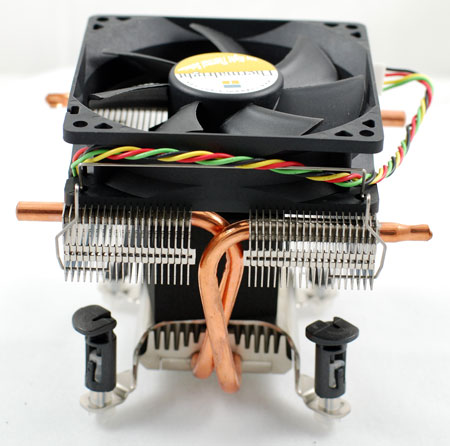
The 9775 comes standard with a 92mm fan, which is larger than Intel's stock 80mm. This allows the fan to turn more slowly to produce the same air volume as an 80mm, or the extra size can be used to increase air volume and cooling.
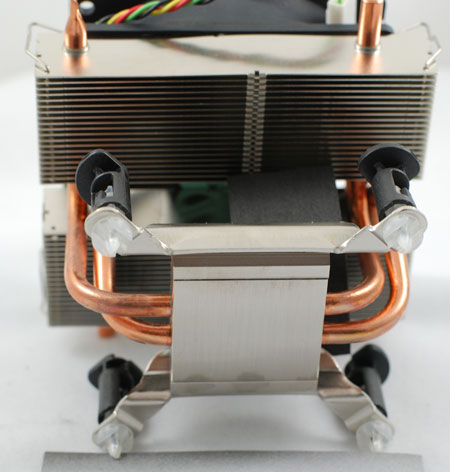
Thermalright also uses a 4-pin fan connector, just like Intel does. That means pin 4 can be used to dynamically control fan speed. While the 9775 fan operates just fine, you can also substitute another 92mm fan if you choose, just like on more expensive Thermalright heatsinks. The fan attaches with typical Thermalright wire clips.
Scythe Katana
Scythe produces a wide range of air cooling solutions for the computer enthusiast. There are currently about a dozen air cooling solutions detailed on the company website. These range from entry level cooling solutions all the way to powerful cooling tower designs.
Scythe Co., Ltd is a Japanese company located in Tokyo. Beginning in 2002 Scythe started manufacturing and distributing products for the PC enthusiast, including CPU cooling solutions. Scythe's first product, the Scythe Samurai, developed quite a reputation among computer enthusiasts. Their current catalog includes the well-known full cooling tower solution, the Scythe Infinity.
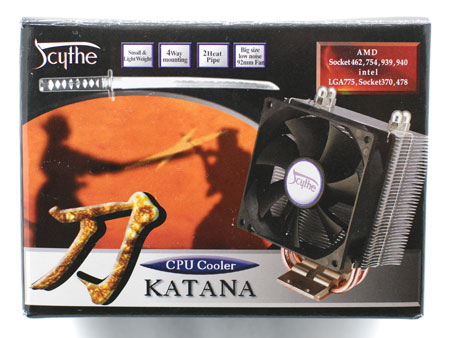
Scythe likes using full color graphics and Japanese fight themes in their packaging. The Katana is no exception.
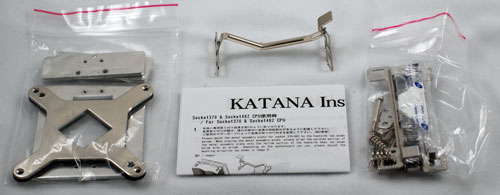
While the Thermalright MST-9775 is designed to support just the Socket 775, the Katana includes an incredible array of hardware to adapt it to AMD Socket A (462), 754/939/940, Intel 370, Intel 478, and Intel 775. It should also be mentioned that Katana is one of the few current coolers that actually meets AMD's recommendation of 300g maximum weight for Socket A coolers.
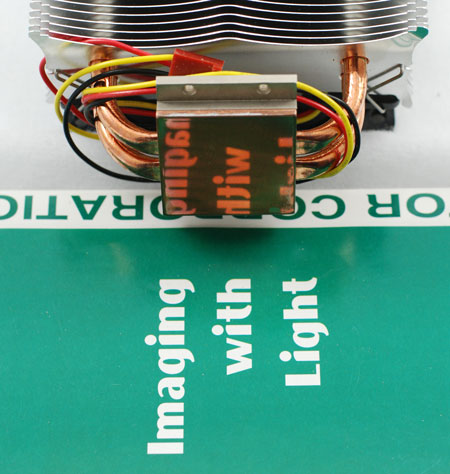
The mounting surface of Katana is highly polished. Many do not believe this matters much on processors with integral heatspreaders like Core 2 Duo, P4, Socket 478 and AM2. However, a smooth mating surface does matter a great deal on small surface area processors like Athlon XP and other Socket A designs.
With Katana supporting so many different sockets, it should be no surprise that some installations are easier than others. Installation on Socket A is a breeze, but Socket 775 installation is a nightmare. The motherboard has to be removed from the case to install the back plate and adapters which basically make 775 into a Socket 478 cage. Then you have to install flat "clips" with a set screw to create the pressure to hold the cooler in place - all while holding the cooler.
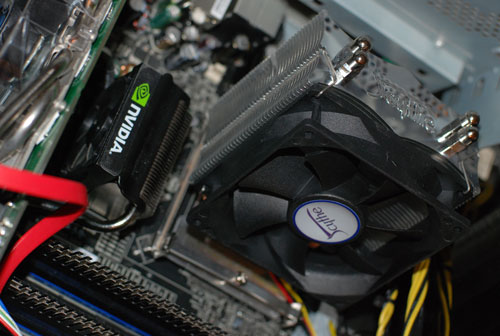
The point is the installation is possible, but we could find no way to do it in a case. Install the cooler before remounting the motherboard. The finished Core 2 Duo install took a while, but once it is done properly, the cooler works just fine on a Core 2 Duo processor.
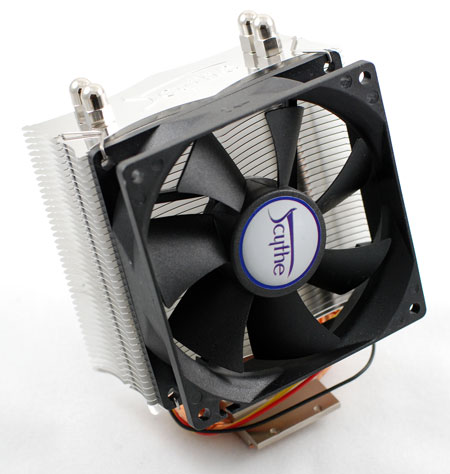
Scythe also suggests that the Katana be mounted so the fan, which blows through the fins/heatpipes, is aimed toward a rear exhaust. This works well in cases with a top-mounted power supply. In designs with the power supply at the bottom of the case a top exhaust should also work fine.
The Scythe Katana uses a large 92mm fan that runs at just one speed - 2000rpm. There are no provisions for variable fan speed, but you can add a fan controller like the Zalman if you want. There is also an upgraded Katana model - the Katana CU - which adds all copper construction and a fan controller to the base Katana for about $15 more (total $40).
CPU Cooling Test Configuration
A requirement for any cooling test bed is a reliable utility for measuring CPU temperature and fan speed. The utility also must be usable while other programs are running so the impact of stress testing can be assessed. After evaluating a number of Intel 975/965 and NVIDIA 680i motherboards the decision was reached to use the NVIDIA 680i as the cooling test bed. This was primarily based on the excellent temperature measurement utility, NVIDIA Monitor, which is part of the nTune program.
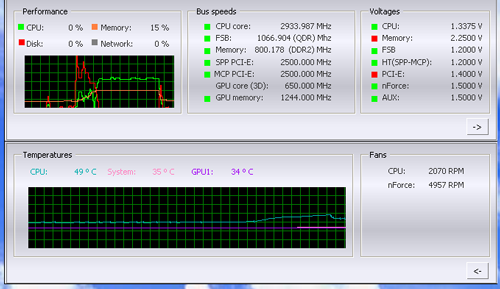
NVIDIA Monitor has a drop-down pane for temperature measurement which reports CPU, System, and GPU measurement. At this point we will concentrate primarily on CPU temperature with listings of system temps for reference. In addition to the real-time temperature measurement, NVIDIA Monitor also has a logging feature which can record temperature in a file in standard increments (we selected every 4 seconds). This allows recording of temperatures during testing and play back, for example, of stress test results that can then be examined when the stress tests are completed. There is also the handy reference of speeds and voltages in the top pane to confirm the test setup.
Other components in the cooling test bed are generally the same as those used in our motherboard and memory test bed:
| Cooling Performance Test Configuration | |
| Processor: | Intel Core 2 Duo X6800 (x2, 2.93GHz, 4MB Unified Cache) |
| RAM: | 2x1GB Corsair Dominator PC2-8888 (DDR2-1111) |
| Hard Drive: | Hitachi 250GB SATA2 enabled (16MB Buffer) |
| Video Card: | 1 x EVGA 7900GTX - All Standard Tests |
| Platform Drivers: | NVIDIA 9.53 |
| NVIDIA nTune: | 5.05.22.00 (1/16/2007) |
| Video Drivers: | NVIDIA 93.71 |
| CPU Cooling: | Thermalright MST-9775 Scythe Katana Tuniq Tower 120 Intel Stock HSF for X6800 |
| Power Supply: | OCZ PowerStream 520W |
| Motherboards: | EVGA nForce 680i SLI (NVIDIA 680i) |
| Operating System: | Windows XP Professional SP2 |
| BIOS: | Award P24 (1/12/2007) |
We first tested the stock Intel cooler at standard X6800 speed, measuring the CPU temperature at idle and while the CPU was being stressed. We stressed the CPU by running continuous loops of the Far Cry River demo. The same tests were repeated at the highest stable overclock we could achieve with the stock cooler. Stable in this case meant the ability to handle our Far Cry looping for at least 30 minutes.
| X6800 CPU Operating Temperature Standard Intel Heatsink/Fan (Ambient Temperature 21C (70F) |
||
| CPU | System | |
| IDLE 2.93GHz | 41C (106F) | 32C (90F) |
| STRESS 2.93GHz | 56C (133F) | 33C (91F) |
| IDLE 3.73GHz | 56C (133F) | 37C (99F) |
| STRESS 3.73GHz | 71C (160F) | 38C (100F) |
The same tests were then run on the cooler under test at stock, highest stock cooler OC speed (3.73GHz), and the highest OC that could be achieved in the same setup with the cooler being tested. This allows measurement of the cooling efficiency of the test unit compared to stock and the improvement in overclocking capabilities, if any, from using the test cooler.
Noise Levels
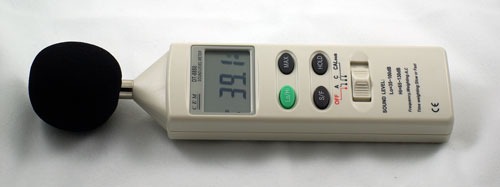
In addition to cooling efficiency and overclocking abilities, users shopping for CPU cooling solutions may also be interested in the noise levels of the cooling devices they are considering. Noise levels are measured using a C. E. M. DT-8850 Sound Level meter. This meter allows accurate sound level measurements from 35bdB to 130dB with a resolution of 0.1dB and an accuracy of 1.5dB. This is sufficient for our needs in these tests, as measurement starts at the level of a relatively quiet room. Our own test room, with all computers and fans turned off, has a room noise level of 36.4dB.
Our procedures for measuring cooling system noise are described on page 6 along with noise results comparing the stock Intel cooler to the tested coolers.
Cooling Results
Both the Thermalright MST-9775 and the Scythe Katana outperform the retail Intel X6800 HSF at idle. Their performance is very similar, but not up to the cooling performance of the Tuniq Tower 120.
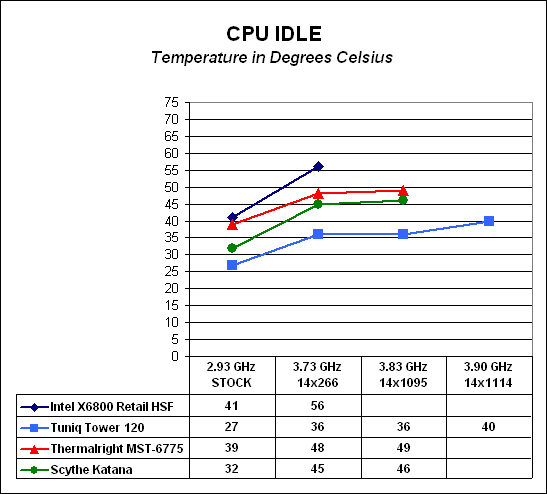
Where the very good Intel stock cooler keeps the X6800 at 41C at idle, the Thermalright MST-9775 manages 39C, which is a slight improvement. The Scythe Katana does even better in reducing idle processor temperature to 32C. However, neither of these $25 coolers can match the 27C we measured with the more expensive Tuniq Tower 120.
As the processor is pushed to its highest stable overclock using the retail HSF, the delta increases. At 3.73GHz the retail HSF is running at 56C, compared to 48C with the Thermalright and 45C with the Katana. The Katana and Thermalright perform similarly, which should not be too surprising considering both use a 92mm fan and both use a similar heatpipe/fin assembly - even though they really do look very different. The difference in performance between the Katana and MST-9775 is most likely due to the auto speed reduction of the MST-9775 as a result of the 4-pin fan connector. We performed several measurements of the two coolers at similar fan speeds and found results were very close, with a slight edge to the Scythe Katana.
The Scythe Katana reaches a slightly higher overclock of 3.81GHz compared to the highest 3.78GHz with the MST-9775. At the highest overclock each cooler reached the Katana was about 3C cooler at idle.
It is easy to measure the effectiveness of a cooling solution at idle - when the computer is doing nothing except running the temperature measurement program. It is more difficult, however, to effectively simulate a computer being stressed by all of the conditions it might be exposed to in different operating environments. For most home users CPU power is most taxed with contemporary gaming. Therefore our stress test simulates running a demanding contemporary game.
The Far Cry River demo is looped for 30 minutes and the CPU temperature is captured at 4 second intervals with the NVIDIA monitor "logging" option. The highest temperature during the stress test is then reported. We did try other variations in "stressing" the CPU, but multitasking variations did not produce higher temperatures than looping the Far Cry River demo. For that reason, we settled on the simple stress test of looping a demanding Far Cry demo for 30 minutes.
Cooling efficiency of the MST-9775 and Katana were compared to the retail HSF and the Tuniq Tower 120 measured under these stress conditions. It is very interesting that under stress conditions the performance curves of the MST-9775 and Katana get closer as speed increases. This confirms our suspicion that the biggest performance differences between these two coolers are likely the results of the Thermalright's variable fan speed.
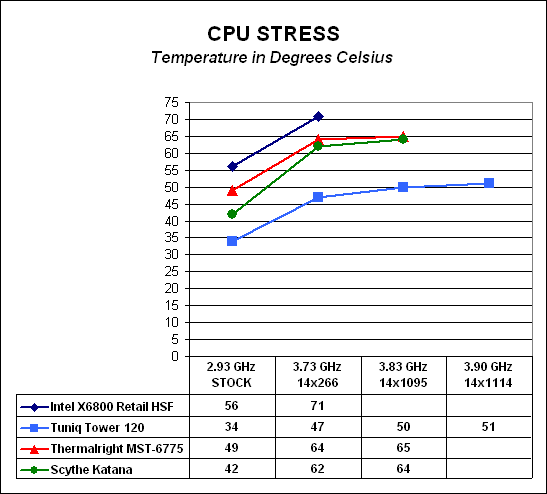
Both the MST-9775 and the Katana perform solidly between the retail Intel cooler and the Tuniq Tower when stressed and temperatures are measured at increasing overclocks. This is another way of saying the Thermalright MST-9775 and Scythe Katana both outperform the stock Intel HSF, but they are not the equal of the more expensive Tuniq. You can see that as processor speed increases the delta between these coolers and the Intel gets smaller - indicating they are not nearly as robust a cooling solution as the Tuniq. This should not be a surprise to anyone, since the Tuniq Tower 120 costs twice as much as the MST-9775 or Katana.
The performance of both of these under $30 coolers is very good. Either outperforms the Intel retail cooler, and both provide good value. They do not match the best cooling performance we have tested, but they do well considering what they cost.
As for the overclocking abilities of the CPU, they will vary at the top. This particular CPU does higher FSB speeds than any X6800 we have tested, but the 3.9GHz top speed with the Tuniq is pretty average among the X6800 processors we have tested. A few of the other processors tested with the best air coolers reach just over 4 GHz, but the range has been 3.8 to 4.0GHz. Stock cooling generally tops out 200 to 400Mhz lower, depending on the CPU, on the processors tested in our lab.
Overclocking
When cooling solutions do a better job of keeping the CPU at a lower temperature, it is reasonable to expect the overclocking capabilities of the CPU will increase. In each test of a cooler we measure the highest stable overclock of our standard X6800 processor under the following conditions:
CPU Multiplier: 14x (Stock 11x)
CPU voltage: 1.5875V
FSB Voltage: 1.30V
Memory Voltage: 2.20V
nForce SPP Voltage: 1.5V
nForce MCP Voltage: 1.7V
HT nForce SPP <-> MCP: Auto
Memory is set to Auto timings on the 680i and memory speed is linked to the FSB for the overclocking tests. This removes memory as any kind of impediment to the maximum stable overclock. Linked settings on the 680i are a 1066FSB to a DDR2 memory speed of DDR2-800. As FSB is raised the linked memory speed increases in proportion. The same processor is used in all cooling tests to ensure comparable results.
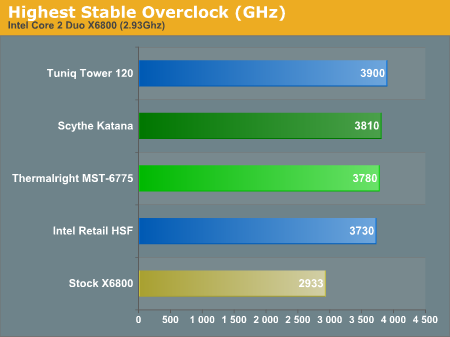
Both the Thermalright MST-9775 and the Scythe Katana enable higher overclocks than the stock Intel cooler. Neither of the coolers under test, however, comes close to the overclocking performance of the Tuniq Tower 120. Where the stock cooler reached 3.73GHz with this CPU, the Thermalright extends this to 3.78GHz, the Scythe Katana allows a stable 3.81GHz, and the same processor reached a stable 3.90GHz with the Tuniq Tower.
Noise
For some users the goal is maximum stable overclock, and they will live with the inconvenience of a louder system. For others silence is the most important factor, and these users will forgo overclocking if this increases system noise levels. Both the Thermalright MST-9775 and the Scythe Katana use 92mm fans running at a relatively slow 2000rpm to reduce noise while still maintaining high air flow for cooling. This is a particularly large fan for cooling solutions aimed at the value end of the cooler market.
In addition, the 4 pin fan connector used by the MST-9775 allows the system to automatically vary fan speed based on CPU temperature. In testing we found the variation between the Auto low and high speeds to be around 1000rpm on low and 2000rpm on high speed. As a result of the variable fan speed results at both low and high fan speeds were measured and reported for the Thermalright.
There are virtually no power supplies that do not have a fan. While Zalman and a few others do make a few expensive fanless power supplies, we are not aware of one that is larger than 500W, or that would be used for seriously overclocking a system. With that in mind the noise level of the system with all fans turned off except the Power Supply was measured. The power supply used for the cooling test bed was the OCZ PowerStream 520, which is one of the quieter high performance power supplies. The noise level of the Power Supply was 38.3db from 24" (61cm) and 47db from 6" (152mm). The measured noise level of the test room is 36.4db, which would be considered a relatively quiet room with a noise floor below the OCZ PowerStream 520 PSU.
Keep in perspective that the dB scale is logarithmic and not linear, so a 3dB increase represents a doubling of sound power. Some studies suggest that while the human ear can discern small differences in sound level, the human ear perceives a doubling of loudness at a 10dB increase. Others quote double the sound level perception as 6db.
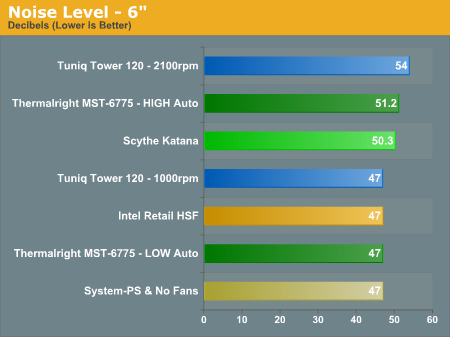
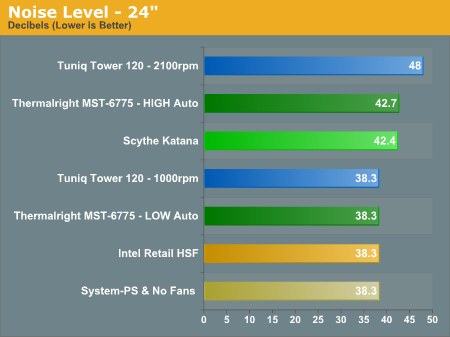
Measured noise levels in this chart should be considered worst case. Measurements were taken with an open side of a mid tower case 6" from the HSF and 24" from the HSF. Real world would be a completely closed case with a further reduction in noise.
Subjectively the Scythe and Thermalright were both quiet at the standard fan speed of 2000rpm. However, neither cooler was really as quiet as a stock Intel HSF. The increase in noise will be hardly noticed by most users since the noise increase is small and the noise frequency is not particularly irritating.
When the Thermalright MST-9775 drops to low speed on Auto the measured noise is below the system noise floor. If minimum noise is your goal, a fan speed controller could easily be added to the Katana or the MST-9775 to keep noise levels below the system floor. We found just below top speed - about 1800rpm - dropped measured noise below the system floor.
Final Words
Effective CPU cooling is really very simple and should accomplish the following:
- Lowering the processor temperature compared to the retail HSF. If an after market cooling solution does not perform better than the kit heatsink, there is no real reason to buy it.
- Higher overclocking compared to the retail HSF. A cooler CPU could result in a longer CPU life, but most users upgrade cooling to overclock even further than is possible with a stock HSF.
- Lower noise than Stock Cooling. For some this is an optional requirement, while for others it is extremely important. Effective cooling and noise reduction are often at odds in effective cooling, but some coolers manage this task better than others.
The Thermalright MST-9775 is a good replacement for the Intel HSF for those looking for value, small cases, or traveling PCs. It cools better than the Intel retail HSF and allows overclocking about 50MHz further than the stock HSF. Installation on the Intel Socket 775 (Socket T) is very easy - as easy as the Intel retail unit. Noise is below the retail CPU at low auto speeds and a bit louder at higher fan speeds. The MST-9775 is small and should fit almost any motherboard and case combo. If you need something even smaller Thermalright has a low-profile OEM model. The MST-9775 also features a 4-pin fan connector that allows pin 4 to control fan speed.
The Thermalright disadvantages are that it will only fit Socket 775. Of course that is where today's best overclocking chips reside, so it is only a disadvantage if you are trying to OC and cool a processor that fits a different socket.
The Scythe Katana also cools better than the Intel retail HSF. In fact at most speeds it cools better than the Thermalright. This is mainly due to the fact that the Katana does not have a variable fan speed like the MST-9775 has. The Katana overclocks further than the retail HSF and slightly outperforms the OC of the Thermalright. The Katana is also a universal heatsink, and comes with the necessary hardware to fit any current socket except AM2. If you are cooling Socket A the Katana is probably the best cooler you can buy, as it is one of the very few to actually meet the Socket A weight limit of 300g.
The universal fit of Katana is also its downfall. Installation on Socket 775 is absolutely horrible, requiring more time and patience than most people possess. However, if you hang in there and attach Katana while the motherboard is out of the case you will be rewarded with very good performance on Core 2 Duo. Katana also does not have a fan controller, which means it is a bit noisier than the Intel retail HSF. You can add a fan controller and correct this or opt for the more expensive Katana CU which includes a fan controller.
Both the Thermalright MST-9775 and the Scythe Katana are good values at a cost of around $25. They perform better than the Intel retail HSF, though not by a huge margin. However, neither of these bargain towers challenges the top tower heatsinks like the Tuniq Tower 120 in cooling and overclocking efficiency. The MST-9775 and Katana may do all you want to do and they are both worth the money. For those buyers you have found a solution. If you move your PC a lot you should also consider one of these lightweight towers. But those looking for the best air cooling available and the best overclocking of their processor will be better served with a top of the line tower cooler like the Tuniq Tower 120.







